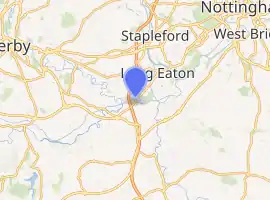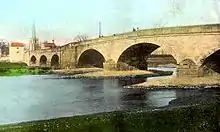Harrington Bridge
Harrington Bridge crosses the River Trent near Sawley in Derbyshire carrying the Tamworth Road (B6540) into Leicestershire. The stonework of the bridge dates from 1790, but the central section was replaced in 1905 after it was damaged by flood water. The central section is the only part of the bridge that is not a listed building.[1]
Harrington Bridge | |
|---|---|
.jpg.webp) Harrington Bridge from the Leicestershire river bank showing the river running much higher than normal | |
| Coordinates | 52.8754°N 1.3012°W |
| Carries | Road traffic; B6540 |
| Crosses | River Trent |
| Heritage status | Grade II listed structure |
| History | |
| Opened | 1790 |
| Statistics | |
| Toll | until 1882 |
| Location | |

| |
History
Crossings at this point date at least from the 14th century when several timber bridges were built. Although one lasted 80 years, they were all washed away and in 1321 a ferry at Sawley was initiated.[2]
The existing bridge dates from 1789 to 1790 and was designed by the bridge engineer and architect, Thomas Harrison of Lancaster.[3] The new bridge was a toll bridge and everyone except locals living in Sawley or Hemington (in Leicestershire) were required to pay the toll. The Lord of the Manor and his servants were also specifically excluded from toll charges. In 1792, a ford to the west of the bridge became impassable as a result of a weir built at Redhill in Nottinghamshire which must have increased the income from tolls.[4] The Lord of the Manor from 1779 was Charles Stanhope, 3rd Earl of Harrington.

The Act of Parliament authorising the construction of the bridge dates from 1788.[5]
Harrington Bridge consisted of six arches of stone, which, with the approaches, were about 100 yards (91 m) yards long, and 15 feet (5 m) wide, with a toll house. The first bridge was washed down by the great flood before it was completed, previous to which here was a ford.[6] The bridge was erected by shareholders, at a cost of around £4,000 (equivalent to $510,000 in 2019),[7] and tolls were levied to those crossing the bridge until 1882.
The bridge was damaged in floods during 1904. In 1906 a two-span riveted steel girder bridge was erected replacing the central section, retaining the original stone approach arches. The remaining parts of the original bridge are recorded in the National Heritage List for England as designated Grade II listed buildings.[1][8][9]
It now carries Tamworth Road, the B6540, (formerly the A453) over the river providing a link between Leicestershire and Derbyshire.
See also
| Next road crossing upstream | River Trent | Next road crossing downstream |
motorway |
Harrington Bridge B6540 Grid reference SK471311 |
Clifton Bridge (Nottingham) A52 |
| Next bridge upstream | River Trent | Next bridge downstream |
motorway |
Harrington Bridge B6540 |
Trent Viaducts |
References
- Historic England, "Stone-built part of Harrington Bridge (1064258)", National Heritage List for England, retrieved 18 August 2013
- "Sawley Historical Society, accessed January 2010". Archived from the original on 28 July 2009. Retrieved 8 January 2010.
- A biographical dictionary of civil engineers in Great Britain and Ireland. A. W. Skempton
- The Long Eaton and Sawley Archive, accessed January 2010
- An Act for building a Bridge over the River Trent at or near Sawley Ferry in the Counties of Derby and Leicester. George III, CAP. 80
- Directory of Derbyshire. 1857. White.
- UK Retail Price Index inflation figures are based on data from Clark, Gregory (2017). "The Annual RPI and Average Earnings for Britain, 1209 to Present (New Series)". MeasuringWorth. Retrieved 2 February 2020.
- Historic England, "North section of Harrington Bridge (1087977)", National Heritage List for England, retrieved 18 August 2013
- Historic England, "Section of Harrington Bridge (1204305)", National Heritage List for England, retrieved 18 August 2013
Sources
External links
![]() Media related to Harrington Bridge at Wikimedia Commons
Media related to Harrington Bridge at Wikimedia Commons